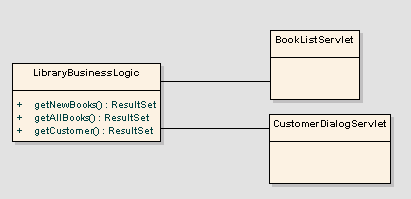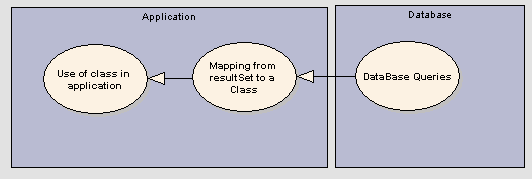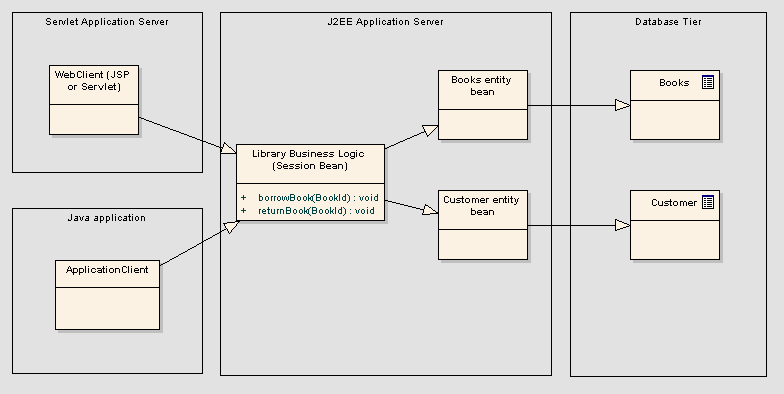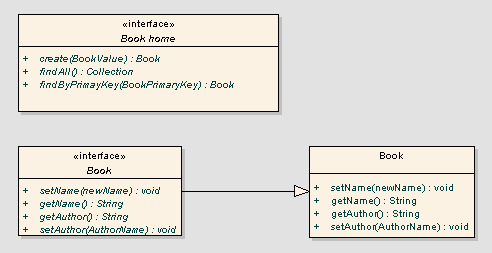Java Database Development for web applications
-
How to access databases in web applications
-
Introductions to available technologies and why to use them
-
Short comparison of EJB, Hibernate and JDO
Introduction
In this article I will explain why you should not develop in java as some people do it with perl or php. I will show you why it is useful to separate dababase and application logic and finally what technologies you may use.
In terms: You will find information about Object Relational Mapping, Multi-Tier development, and persistence technologies like Enterprise Java Beans and Hibernate.
Table of Contents
Java Database Development for web applications 1
Introduction 1
Bad use of db access in web script development 1
Use classes instead of resultSets (Object relational mapping) 2
Stop writing create, edit, delete statements (persistence technologies) 3
Available persistence technologies 4
EJB (Enterprise Java Beans) ( Sun ) 4
Hibernate (Open Source) 5
JDO (mostly professional solutions) 7
Choosing your persistence technology 7
Bad use of db access in web script development
Some people develop their web applications with script languages which may directly be included in the source code. The source for a page, that lists books, looks like
<html><head><title>Important title</title></head>
<body>
<someScript>
dbConnection = openDBConnection(someDB)
resultSet = dbConnection.executeQuery('select bookName from books')
loop over resultSet{
print (resultSet.field('bookName') + '<br>')
}
</someScript>
</body></html>
You can develop the same way using java servlets. But this way to development is only suitable for tiny projects. Imagine you have 70 dialogs, lots of queries and you want to add a status field to your book table indicating if a book is deleted or not. You will have to look through all your dialogs.
This is where Multi Tier development starts. A first step is to get the db queries out of the dialogs. Using Servlets for your dialogs, you can implement this by a central class providing all queries you need. In our example this class is named LibraryBusinessLogic.

Example
source code of a java servlet:
protected void doGet(HttpServletRequest request, HttpServletResponse response)
throws ServletException, IOException {
PrintWriter out = response.getWriter();
out.print("<html><head><title>My Servlet</title></head><body>");
// [laliluna] 09.11.2004 create instance of my business logic class
LibraryBusinessLogic libBL = new LibraryBusinessLogic();
ResultSet books = libBL.getAllBooks();
try {
while (books.next())
out.print(books.getString('name'));
} catch (SQLException e) {
e.printStackTrace();
}
}
Use classes instead of resultSets (Object relational mapping)
The disadvantage from our example above is that we have to know what the database looks like and how the fields are spelled. We have no error message from the Development Environment showing that a call to a resultSet like
books.getString('badName')
is wrong. Only at run time we can see the problem. There is a easy solution to this problem, it is called object relational mapping. Instead of working directly with a result set from a query, you copy each entry of the result set to a java class.

Our class LibraryBusinessLogic is doing something more now:
-
Call to database with normal JDBC (Java Database Connectivity)
-
Copy ResultSet to a List or Array of Class instances (e.g. Book [])
-
Return List/Array of class instances
Our servlet looks a little different now:
protected void doPost(HttpServletRequest request, HttpServletResponse response)
throws ServletException, IOException {
PrintWriter out = response.getWriter();
out.print("<html><head><title>My Servlet</title></head><body>");
// [laliluna] 09.11.2004 create instance of my business logic class
LibraryBusinessLogic libBL = new LibraryBusinessLogic();
List books = libBL.getAllBooks();
for (Iterator iter = books.iterator(); iter.hasNext();) {
Book book = (Book) iter.next();
out.print("Bookname: " + book.getName() + "<br>");
}
}
This is nice, isn't it?
So let's go on to improve our database development style.
Stop writing create, edit, delete statements (persistence technologies)
In an average application: What do you think how much percent of the queries do only create/update/delete an entry in a table?
Do you think that it should be your job to write these tedious statements? Then help is close to you. Persistence technologies do exactly what you need.
Persistence = write data to somewhere where it can stay for ever, normally a database
Based on a class and a description file (often in xml) of the table mapping, the persistence technology knows from which table it has to read the data.
Loading classes from the database looks like
Query query = session.createQuery("select b from Bug as b");
for (Iterator iter = query.iterate(); iter.hasNext();) {
bugs.add((Bug) iter.next());
}
return bugs;
saving a bug to the database looks like
session.update(bug);
There are as far as I know, three major persistence technologies available:
-
EJB (Enterprise Java Beans)
-
JDO (Java data objects)
-
Hibernate
They do not only provide persistence but also functionalities like caching, Business logic on the application server, clustering, recover strategies, transaction management, database connection pooling and much more.
They do a lot for you. And in my humble opinion, when you develop any kind of application with database access, you should use persistence technology.
Available persistence technologies
EJB (Enterprise Java Beans) (� Sun )
EJBs are probably the standard technology to persist (save) classes to databases. Every application server supporting J2EE provides native functionality for EJBs.
The general structure of a J2EE application is displayed below.
The Entity EJBs (persistence part) are only one type of EJBs. There are also Session Beans to provide the business logic.

For an entity bean you need the class, the interfaces and an xml description file. The interfaces give access to the class and its corresponding database entry. The xml description file is to let the application server know to which table he has to map the class and to which column a field.

When you use create an entry in the database with an entity EJB you will do the following steps
-
get the home interface from the Application Server
-
call the create method of the interface, it will return the book interface
-
with the book interface you can change the values in the database.
When you want to read an existing value from the database you use the home interface again and call the findByPrimaryKey method. This method will return the interface with which you can change the values of your data entry.
This is not very complicated in the end.
When you develop an entity EJB you have to
-
create the class
-
implement the home and the class interface
-
create a description file, which explains the Application Server to which table your entity EJB is mapped.
Below you can see an example for a mapping description:
<entity >
<description><![CDATA[SimpleBean EJB]]></description>
<display-name>SimpleBean</display-name>
<ejb-name>SimpleBean</ejb-name>
<home>de.laliluna.tutorial.simpleBean.interfaces.SimpleBeanHome</home>
<remote>de.laliluna.tutorial.simpleBean.interfaces.SimpleBean</remote>
<local-home>de.laliluna.tutorial.simpleBean.interfaces.SimpleBeanLocalHome</local-home>
<local>de.laliluna.tutorial.simpleBean.interfaces.SimpleBeanLocal</local>
<ejb-class>de.laliluna.tutorial.simpleBean.ejb.SimpleBeanCMP</ejb-class>
<persistence-type>Container</persistence-type>
<prim-key-class>java.lang.String</prim-key-class>
<reentrant>False</reentrant>
<cmp-version>2.x</cmp-version>
<abstract-schema-name>SimpleBean</abstract-schema-name>
<cmp-field >
<description><![CDATA[]]></description>
<field-name>id</field-name>
</cmp-field>
<cmp-field >
<description><![CDATA[]]></description>
<field-name>name</field-name>
</cmp-field>
<primkey-field>id</primkey-field>
</entity>
The creation of the interfaces and the description file is a tedious task. It is a good idea to use MyEclipse because it generates all this for you. You only have to implement the class.
Hibernate (Open Source)
Hibernate is a object/relational persistence and query service for Java. Comparing to EJB technology it is the alternative to Entity EJBs. It this does not provide a business logic part like the session beans but of course (and this is a good idea) you can implement the business logic with session beans and use hibernate in the session beans instead of entity beans.
What is nice and in my opinion an advantage over entity beans, hibernate starts from simple java classes (Pojo = Plain Old Java Objects).
To use hibernate you will create a simple java class:
public class Bug
implements Serializable
{
private int hashValue = 0;
private java.lang.Integer id;
private java.lang.String title;
public AbstractBug()
{
}
public AbstractBug(java.lang.Integer fid)
{
this.setId(fid);
}
public java.lang.Integer getId() {
return id;
}
public void setId(java.lang.Integer id) {
this.id = id;
}
public java.lang.String getTitle() {
return title;
}
public void setTitle(java.lang.String title) {
this.title = title;
}
.............
Than you create a mapping file which is the equivalent to the EJB mapping file.
<hibernate-mapping package="de.laliluna.fehlerbehebung">
<class name="Bug" table="bug">
<id name="id" column="fid" type="java.lang.Integer">
<generator class="sequence">
<param name="sequence">public.bug_fid_seq</param>
</generator>
</id>
<property name="title" column="ftitle" type="java.lang.String" />
</class>
</hibernate-mapping>
And you start using your hibernate class.
Example to create a new entry in the database:
try {
Bug bug = new Bug();
bug.setTitle("Title");
bug.setTuserFk(tuser);
Transaction tx = session.beginTransaction();
session.save(bug);
tx.commit();
} catch (HibernateException e) {
e.printStackTrace();
}
There is no need for any interfaces like with EJBs.
The creation of the description file can be done with tools like MyEclipse. MyEclipse provides functionality to create classes and description files directly from database tables.
Hibernate includes tools to
-
generate Java classes from description files
-
description files from existing database tables
-
database tables from description files.
A development speed is very high using hibernate.
JDO (mostly professional solutions)
I have to apologize myself, but I do not have any practical experience with JDO and I do not want to copy any information I cannot approve. It is supposed to be somewhere in the middle between Hibernate and EJB but closer to Hibernate.;-)
What I saw before about JDO it is really very close to Hibernate. There is a JDO standard the companies follows. The most solutions are payable and I question if it is useful to buy something when you can use well established technologies like Entity EJBs or Hibernate.
Choosing your persistence technology
EJB is the standard, hibernate is the more flexible nice guy.
|
EJB persistence |
Hibernate persistence |
|---|---|
|
Standard solution Natively integrated in all J2EE servers Optimizations directly available from the application server Monitoring Tools and everything you need Object oriented query language EJB-QL is limited. |
Probably most popular open source persistence technology Very sophisticated mapping technology (polymorphism, composition, ...) Works with all application servers, even with servlet application servers (Tomcat). Object oriented query language is more complete than EJB-QL No problems using SQL directly |
We used EJBs a lot but there are a lot of things why I prefer Hibernate in most but not in all projects now. One thing is sure, you can use both technologies for most development projects. It depends on your focus. When the native support of EJB is important to you and you want to use the monitoring tools of your application server, you should go for EJB technology.
When you want to be less limited by the query language and want to use sophisticated mappings, your choice is probably Hibernate. When you want something less complex and you are a beginner, you should also go for hibernate.
As stated before, you may use Session EJBs for Business Logic and Hibernate to persist data. So these two technologies are not completely exclusive. Try our little tutorials to get a impression of both technologies and take your choice later.
I hope I could help you a little bit.
Sebastian